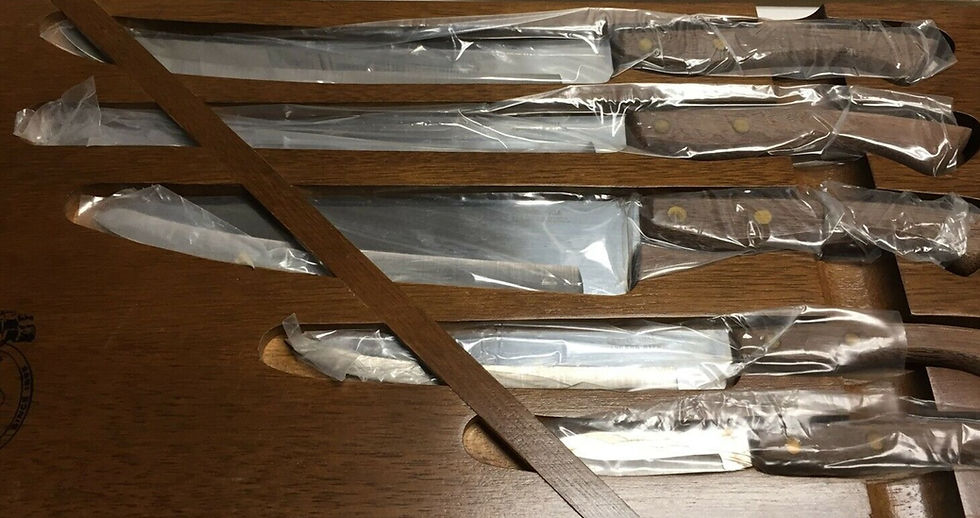Carvel Hall Confusion: A Hotel or a Knife Company?
- HistoricAnnapolis

- Jun 10, 2020
- 3 min read
When you mention the name Carvel Hall, you may instantly think of the hotel that once was at the William Paca House...or the knife company famous for their steak and crab knives. While the hotel and the knife company shared the name “Carvel Hall,” they had no formal relationship. So how did two entities in Maryland end up with the same name?
National tennis champion William Larned bought the William Paca House in 1901 and began to convert the property into a hotel. By February 1903, at least a portion of the hotel was completed, and by October 1903, the hotel in its entirety was open with a large addition attached to the back of the colonial house and extending over most of the old garden. Larned named his hotel Carvel Hall, after the title character of a popular 1899 novel, Richard Carvel, by the American writer Winston Churchill. The hotel became synonymous with Annapolis life and culture. USNA midshipmen celebrated there with friends and family, and state representatives lived there while legislature was in session. The hotel became known far and wide as the place to stay in Annapolis.

In 1895 on Maryland’s eastern shore, Charles D. Biddle’s blacksmith shop was making everything from farm equipment to letter openers. After a partnership with an employee Paul Culver in the late 1940s, the company transitioned to making steak knives.
With the new product line, they needed a new name for the product. They wanted a, “name of historic significance that would be of much appeal to the mind as the knife was to the eye” [i]. The Daily Times went on to report that the owners, “thought of Carvel Hall, the famous hostelry at Annapolis. The great men of colonial America had sat at its table…and was famous as a colonial home and later as a hotel at the seat of Maryland’s government” [ii]. The steak knives were an instant hit, selling $1 million in the first month [iii]. After successfully launching their Carvel Hall knife line, the company decided to rebrand and change its name to Carvel Hall.

Adding to the confusion, objects like this knife set, recently acquired into Historic Annapolis’s collection, features an image of Carvel Hall - the hotel in Annapolis - on the cover of the Carvel Hall knife brand’s set. This box for the #1942 Buccaneer Cutlery Set has a sketch of what Carvel Hall hotel looked like at the time, but also features the knife company’s logo.

Confusion over whether or not the hotel and knife company were a joint venture has been an ongoing problem. On July 1, 1965, Carvel Hall hotel closed its doors to the public and its closure was widely reported. Later in the month on July 20, 1965, The Daily Times ran an article entitled “Confusion Caused by Similar Name” in which a sales manager for the knife company explained how some clients were surprised to still see him working as they thought the company has closed [iv].
Ultimately, the knife company Carvel Hall closed as well in 1990 [v], leaving both the hotel and knife company just a memory with various pieces of ephemera to tell their stories.
Robin Matty Curator of Collections
#history #decorativearts #annapolis #annapolishistory #annapolislandmarks #historicannapolis #curator #curatorscorner
Resources: [i] “Carvel Hall Won Instant Appeal.” The Daily Times. January 28, 1953. [ii] “Carvel Hall Won Instant Appeal.” The Daily Times. January 28, 1953.
[iii] Duffy, Jim. “Somerset Journey: The Steak Knife Was Invented in Crisfield, and That Story Begins on Marumsco Creek.” Secrets of the Eastern Shore, March 31, 2020. https://www.secretsoftheeasternshore.com/somerset-journey-steak-knife/. [iv] “Confusion Caused by Similar Name.” The Daily Times. July 20, 1965. [v] Duffy, Jim. “Somerset Journey: The Steak Knife Was Invented in Crisfield, and That Story Begins on Marumsco Creek.” Secrets of the Eastern Shore, March 31, 2020. https://www.secretsoftheeasternshore.com/somerset-journey-steak-knife/.








Comments